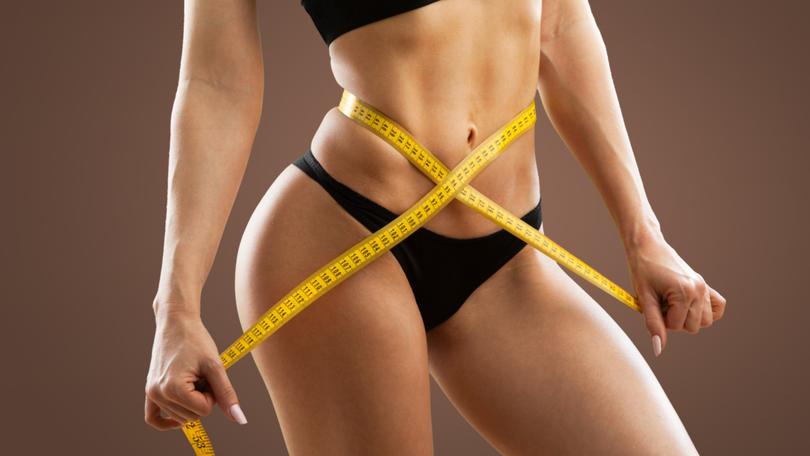Forget Ozempic you can think yourself slim with the ‘hypno-jab’, says clinical hypnotherapist Jules Abernethy

Dieting is hard.
It’s why the idea of a weekly weight-loss injection that does all the work for you, like Ozempic, is so tempting — especially when you see the remarkable transformations of celebrities who admit using it, such as Sharon Osbourne and Oprah Winfrey.
The way these jabs work is fascinating.
Sign up to The Nightly's newsletters.
Get the first look at the digital newspaper, curated daily stories and breaking headlines delivered to your inbox.
By continuing you agree to our Terms and Privacy Policy.The drug itself is called semaglutide (branded as Ozempic or Wegovy), and one way it works is by mimicking a hormone the body produces naturally when full, called gLP-1.
By feeding back the message to the brain that our appetite is sated, it dials down feelings of hunger, and even interest in food, which leads to weight loss.
But there are drawbacks, not least the cost — to source Ozempic for the purpose of shedding weight, rather than the diabetes it’s licensed for on the NHS, you have to pay up to £285 (AUD$545) a month for the highest dose.
And it stops working when you stop taking it, so that’s up to £3,420 (AUD$6500) a year to stay slim.
There are side-effects too.
Many users report nausea and vomiting (Boris Johnson says this is what ended his Ozempic journey), and few escape without what is euphemistically called “digestive disturbances”.
But what if there were a way to replicate its benefits with none of those hideous effects, and for free?
What if — instead of injecting yourself with a chemical serum — you could use the hidden power of your own mind to do it?
I’m perfectly serious.
I’ve been using my qualification in applied psychology and postgraduate training at the London College of Clinical Hypnotherapy to help women lose weight for the past 14 years.
On average, at the retreats I run in Dorset, participants lose eight pounds in a single week.
Now I’ve fine-tuned all my experience and knowledge to create a powerfully effective “hypno-jab” in the form of a 30-minute audio download.
For the truth is, by “implanting” the suggestion that the satiety signals in your brain fire up every time you eat, clinical hypnosis can suppress your appetite just as GLP-1 — or Ozempic — does.
It can forge a stronger connection between your brain and that natural feeling of satisfaction and fullness, meaning you won’t want to pile your plate as high as you used to.
This isn’t the same as classic hypnotherapy for weight loss, which is usually tailored to a particular issue, such as binge eating or craving a specific food, and encompasses a wide range of techniques.
It’s no good hypnotising someone to stop eating chocolate if they’re only going to switch their indulgence to Doritos.
My ‘hypno-jab’ is different
Remember the “virtual gastric band”?
Practitioners used this form of hypnotherapy, introduced 15 years ago, to suggest at a subconscious level that someone had undergone bariatric surgery and was therefore able to eat much less than usual.
Its popularity and success showed that being taken, under hypnosis, into a clinical environment and being guided through a surgical procedure entirely of your imagination, really can change the way the cells fire together in the brain.
My hypno-jab takes this one step further, changing the way you think about food and instilling healthy long-term eating habits en route.
Just listening to this audio every day for seven days, then two or three times a week for the next two weeks, can be enough to change your perception of appetite and hunger so you really do start to feel satisfied after eating smaller portions.
Just as you might if you’ve been having the jab.
But the hypnosis also cleverly addresses the disordered eating patterns that very likely caused you to become overweight in the first place.
This is something Ozempic cannot do.
The jabs are just a sticking plaster — once ripped off, the old eating problems remain.
In fact, studies show most people regain at least two-thirds of the weight they’ve lost in the year after stopping the injections.

I’m convinced my hypno-jab is strong enough to match the power of Ozempic and change the way you feel about food for good.
It dulls the appetite and gets to the root cause of why we eat more than we should.
I know — from thousands of clients and also from my own personal experience — that many of our unhelpful eating behaviours are firmly embedded in our psyche.
I was overweight as a child and at my heaviest I weighed 17st (107 kilos) and I’m 5ft 7in (1.7m tall).
I used to hold my size-20 jackets in place with safety pins. Naturally, I tried lots of different diets, but it was only when I was able to apply my knowledge of hypnosis, psychology and a process called Neuro-Linguistic Programming (NLP) — a way of analysing and changing our thinking patterns — that I was able fully to understand and address the underlying factors that influenced my eating habits.
Unprocessed grief led me to self-soothe with sugar, for example.
I still felt the shame and stigma associated with being “the fat girl” at school and not being asked to dance at the disco.
Knowing what lay behind my poor eating habits helped hugely with self-image and motivation, and helped me shed my excess weight for good.
I’ve been a comfortable 11 stone/70kg (wearing 12-14 size clothes) for the past 15 years, and it is the lessons I’ve learned and the expertise I now have that I incorporate into my one-on-one weight loss consultancy, and into my retreats.
They also form the bedrock of my “hypno-jab” program.
So how does it work?
The first step is to dispel any thoughts of stage hypnosis, where watching a swinging pocket watch might leave you clucking like a chicken.
Clinical hypnosis works in a much gentler way by first taking you into a state of deep relaxation, which quietens the critical, conscious part of your mind — the logical, rational part of your brain which might be saying “this will never work” and “it’s not for me” and which can keep you stuck in a negative energy spiral of despair and doubt.
The aim is to find the lovely state between being awake and asleep when your brain is more open to suggestion and change.
Why not try it now?
Sit or lie somewhere comfortable and take three long, slow, deep breaths, allowing yourself to soften and relax.
Now look at the information below for a taster of what you’ll hear when you listen to my needle-free weight-loss hypnosis.
Just reading through this preview can be enough to start to effect change, but I urge you to listen to my voice leading the full hypnosis and to follow the program I recommend.
Repeating the exercise allows the subliminal messaging to build up, creating new neural pathways in the brain and forming connections between what you eat and how you feel.
Each time you listen, you will be better able to let go of the critical, conscious part of your brain and relax more deeply.
The deeper your relaxation, the more open you will be to the suggestions I make, and the more likely to take them on board.
For the first seven days I recommend listening to the hypnosis every day.
Find a quiet, warm spot where you won’t be interrupted, then lie down and close your eyes (it doesn’t matter what time of day you do this).
When you are very familiar with the messaging, you can switch to listening just two or three times a week while you are busy doing other things.
Even if you’re not fully focused on what I’m saying, your subconscious will be getting the positive reinforcement it needs to keep you on track.
After three weeks you can listen to the audio again whenever you want to, or if you need a boost.
Part of my hypnosis is also designed to help generate feelings of positivity and kindness towards ourselves, to counteract some of the self-sabotaging thoughts that so often undermine our best efforts and intentions when it comes to weight loss.
This is a particularly powerful tool for women at menopause.
Midlife can be characterised by anxiety, negativity, poor body image and creeping weight gain that resists all previously successful attempts to diet.
It can leave you feeling hopeless.
My “hypno-jab” can help you feel you’re back in control of your own body.
You’ll notice that as well as hypnotising you to be more closely tuned to “fullness” signals, my program takes the opportunity of your deeply relaxed and suggestible state to reinforce good, healthy eating advice to help change your relationship with food.
Based on decades of solid science, my diet tips are designed to help you start to layer up “micro-habits” such as drinking plenty of water (to remove the possibility of confusing hunger with thirst), eating slowly, and using small salad or tapas-sized plates.
Many of us were brought up to scrape our plates clean, and continue to do so, even though an average dinner plate has expanded in size from nine inches to 14 inches!
This means without realising we could be eating 40 per cent more food, which is seriously stretching our stomach.
An empty stomach is only about the size of a fist and can be happily filled by the food on a nine-inch plate.
However, it can also be easily stretched to accommodate as much as four litres of food and fluid.
Hunger hormones with names such as ghrelin and leptin are created in the lining of your stomach, but when it’s perpetually stretched, their release is impacted and gets out of balance.
Put bluntly, if you eat too much too often, which so many of us do, your body gets overloaded and confused.
What’s more, a lifelong pattern of yo-yo dieting can leave the brain unable to recognise the natural signals our bodies produce to tell us we’re full — the hypno-jab will change all that.
Whatever your background of disordered eating or weight gain, after a few repetitions of my hypnosis, you will start feeling more positive and more aware of when you’re hungry and when you’re full.
It won’t be long before you notice you are eating less and leaving a little on your plate; your jeans are feeling a bit looser and the numbers are falling on your bathroom scales.
I’m not anti-Ozempic, but it is clear to me the weight-loss jab isn’t for everyone. Certainly, it’s not the panacea many people think it is. My hypno-jab could be just as effective — with no cost, pain or side-effects — and much more long-lasting results.
A taster of needle-free hypnosis
Scan down your body, starting at the crown of your head, noticing any areas of tension, and use your cool, calm breath to spread relaxation over your scalp, your forehead and the muscles of your eyes.
As you exhale, notice your cheeks and jaw soften and relax.
Notice relaxation spreading across the shoulders and down the arms to the tips of your fingers, down your back and your front, around the hips and the pelvis, before finally noticing that feeling of relaxation coming down the legs to the soles of your feet.
When you feel deeply relaxed, imagine standing in front of a lift door.
As the doors open, see yourself stepping inside and notice the number panel down one side.
You have entered at level 10 and you want level 1.
See yourself pressing 1 on the button panel.
The doors close in front of you and, as the lift descends, you will feel yourself sinking a little deeper into comfort and relaxation.
When the lift doors open again you realise you are in a clinic and walk towards a door labelled needle-free Weight Loss Hypnosis.
This is the right room for you.
See yourself opening the door and letting yourself into the comfortable waiting room of a modern, well-equipped clinic.
On a large screen, a video is explaining that a Needle-free Weight Loss Hypnosis implant is the latest technology in weight management and a new way of regaining control over eating and helping you develop a positive relationship with food.
You hear that the new implant slowly releases a combination of signals which communicate to the brain a true feeling of long-lasting satiety after eating which helps you feel less hungry so you have less desire to overeat, to eat just for the sake of it or to eat more than you need.
You smile and nod.
This is exactly what you want.
You feel relaxed, calm and in control as you are led into a small private room and you feel no pain at all as a doctor inserts the implant under the skin in your upper abdomen.
You are given a leaflet with guidelines on the new way of eating that you must adhere to over the next 21 days as the implant begins to work.
The guidelines include advice about drinking at least one litre of flat water every day, eating all your main meals from a small saladsized plate, and filling at least half your plate with non-starchy vegetables, one quarter with protein and one quarter with complex carbohydrates.
You will sit down to eat all your main meals and you will eat slowly, savouring every bite of any food you have chosen.
When you start to feel satisfied — before you have completely finished — you will stop eating.
You will no longer finish off every plate of food.
You begin to notice a sense of satisfaction as the implant starts to release powerful supportive signals that will change how you feel about food.
You feel at peace with yourself, knowing that it is OK for you to eat less.
As you say goodbye to the doctor and return to the corridor, you smile.
Something has changed inside you.
You can feel confident in your ability to choose to eat slowly now.
See yourself walking back to the lift, calling the lift, and, inside, pressing the number 10 on the panel.
As the lift rises you feel a sense of lightness coming back and when it arrives at 10, you will be back in the present.
Place a hand over the site of the implant and take three long, slow, deep breaths and acknowledge that change has begun.
For the next 21 days, while the implant continues to work, you follow the guidelines to connect to that feeling of satisfaction where you no longer finish any full portion of food.
